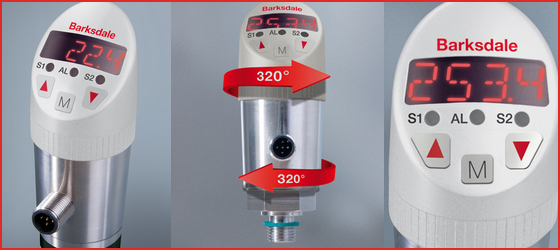|
不同類型的壓力開關(guān)Different types of pressure switches
在最簡(jiǎn)單的形式中, 壓力開關(guān) 是一種能夠檢測(cè)壓力變化并在預(yù)定水平上打開或關(guān)閉電觸點(diǎn)的裝置�。 在這篇文章中, Barksdale 探討了它們的演變�����,從機(jī)電品種到革命性的固態(tài)版本�����,再到今天的尖端電子壓力開關(guān),如 BPS3000��。

壓力開關(guān)分為三個(gè)基本類別:機(jī)電式�、固態(tài)式和電子式。 傳統(tǒng)上�,壓力開關(guān)一直是機(jī)電設(shè)備。 然而�����,今天���,固態(tài)設(shè)備和新型電子壓力開關(guān)(例如 Barksdale 的 BPS3000 )正在向這項(xiàng)相當(dāng)古老的技術(shù)進(jìn)軍。
機(jī)電式壓力開關(guān)
最常見的機(jī)電壓力開關(guān) 由傳感元件和電氣快動(dòng)開關(guān)組成����。 可以使用許多不同類型的傳感元件,但它們有一個(gè)共同點(diǎn):它們會(huì)隨著系統(tǒng)壓力的變化而移動(dòng)���。 通過它們的運(yùn)動(dòng),它們直接作用于快動(dòng)開關(guān)觸點(diǎn)的打開和關(guān)閉�。
差壓開關(guān)略有不同。 有兩個(gè)壓力端口����,一個(gè)用于低壓側(cè)��,另一個(gè)用于高壓側(cè)�����。 低壓和高壓流體作用于同一傳感元件。 由于每一側(cè)的表面積相等�,因此當(dāng)壓力相等時(shí),開關(guān)處于平衡狀態(tài)�����。 隨著高壓側(cè)的壓力增加或低壓側(cè)的壓力降低���,活塞向上移動(dòng)����,并在預(yù)設(shè)的壓差下激活快動(dòng)開關(guān)�。
開關(guān)通常根據(jù)所采用的 傳感器技術(shù) 類型組合在一起。 傳感器的特性往往決定了開關(guān)的相對(duì)精度和壽命���。
典型開關(guān)類別
膜片開關(guān):使用直接作用于快動(dòng)開關(guān)的焊接密封金屬膜片����。
- 壓力高達(dá) 10.43 bar 和真空���。
- 重復(fù)性 ±1%�。
- 低循環(huán)率(小于 25 個(gè)循環(huán)/分鐘)����。
波登管開關(guān):焊接密封波登管用于驅(qū)動(dòng)快動(dòng)開關(guān)。
- 壓力從 3.45 到 1241.06 bar���。
- 重復(fù)性 ±1%��。
- 低循環(huán)率(小于 25 個(gè)循環(huán)/分鐘)��。
隔膜活塞(Dia-Seal 活塞)開關(guān):作用在活塞上的彈性隔膜,進(jìn)而
驅(qū)動(dòng)快動(dòng)開關(guān)�。
- 壓力從真空到 110.32 psi。
- 重復(fù)性 ±2%
- 250 萬次循環(huán)�����。
活塞開關(guān):O 形環(huán)密封活塞直接作用在快動(dòng)開關(guān)上�。
- 壓力達(dá)到 827.37 巴。
- 重復(fù)性 ±2%
- 250 萬次循環(huán)�。
固態(tài)壓力開關(guān)
1980 年,Barksdale 推出了第一個(gè) 固態(tài)壓力開關(guān) ��。 這是一個(gè)結(jié)合了粘合應(yīng)變計(jì)傳感器和雙向可控硅開關(guān)的簡(jiǎn)單裝置�。 如今��,固態(tài)壓力開關(guān)種類繁多����,具有一到四個(gè)或更多開關(guān)點(diǎn)、數(shù)字顯示��、模擬和數(shù)字輸出以及完全可編程性���。
在許多情況下����,它們跨越了從簡(jiǎn)單的開關(guān)到開環(huán)控制器的界限�����。 除了打開或關(guān)閉壓力開關(guān)電路外�,它們還提供比例模擬 4-20 mA 信號(hào)或數(shù)字輸出���。 模擬信號(hào)可以與 PLC(可編程邏輯控制)、DCS(分布式控制系統(tǒng))和計(jì)算機(jī)連接�����。 主要優(yōu)勢(shì)在于循環(huán)壽命���。 固態(tài)開關(guān)的使用壽命通常為 1 億次��。
與機(jī)電開關(guān)相比��,固態(tài)壓力開關(guān)具有許多優(yōu)勢(shì)�����,包括:
- 更長(zhǎng)的循環(huán)壽命��。
- 將精度提高到 ±0.5%����。
- 高抗沖擊和振動(dòng)�。
- 處理各種系統(tǒng)壓力的能力。
- 廣泛的頻率響應(yīng)���。
- 優(yōu)異的長(zhǎng)期穩(wěn)定性。
BPS3000 電子雙壓力開關(guān)
在開創(chuàng)固態(tài)壓力開關(guān)四分之一個(gè)世紀(jì)后����,Barksdale 推出了下一個(gè)改變游戲規(guī)則的產(chǎn)品:BPS3000 電子雙壓力開關(guān)。 這種數(shù)字壓力開關(guān)代表了壓力開關(guān)發(fā)展的下一步�����,并具有一些真正令人印象深刻的屬性��。

- 測(cè)量范圍:表壓:0 - 9000 psig�,絕對(duì)壓力:0 - 150 psia。
- 外殼等級(jí):4X 型 (IP65) / 6 型 (IP67)�����。
- 測(cè)量范圍:0...0.2 bar 至 0...600 bar 表壓(可切換到 psi + Mpa)��。
- 適合室內(nèi)或室外使用��。
- 最大限度�。 2個(gè)開關(guān)點(diǎn)。
- 模擬輸出 4 - 20 mA 或 0 - 10 V����。
- 可旋轉(zhuǎn) 320° 顯示和電氣連接。
- 菜單導(dǎo)航參考 VDMA 標(biāo)準(zhǔn)��。
有關(guān) Barksdale 全系列開關(guān)產(chǎn)品的更多信息�����,請(qǐng)聯(lián)系 010-84282935 或訪問 www.85755448.com.cn�����。
Different types of pressure switches
In its simplest form, a pressure switch is a device capable of detecting a pressure change and, at a predetermined level, opening or closing an electrical contact. In this article Barksdale explores their evolution, from electromechanical varieties, through to the revolutionary solid-state version and today's cutting edge electronic pressure switches, like the BPS3000.
Pressure switches fall under three basic classifications: electromechanical, solid state and electronic. Traditionally, pressure switches have been electromechanical devices. Today, however, inroads into this fairly ancient technology are being made by solid-state devices and the new breed of electronic pressure switches, such as Barksdale's BPS3000 .
Electromechanical Pressure Switches
The most common electromechanical pressure switches are composed of a sensing element and an electrical snap-action switch. A number of different types of sensing elements can be used but they have one thing in common: they move in response to changes in the system pressure. Through their movement they directly act on the opening and closing of the snap-action switch's contacts.
Differential pressure switches are slightly different. There are two pressure ports, one for the low pressure side and the other for the high pressure side. The low pressure and high pressure fluids act on the same sensing element. Since the surface areas are equal on each side, the switch is in equilibrium when the pressures are equal. As pressure on the high-pressure side increases, or pressure on the low side decreases, the piston moves up and, at a preset differential pressure, activates the snap switch.
Switches are commonly grouped together based on the type of sensor technology employed. The characteristics of the sensor tend to define the relative accuracy and life one can expect from the switch.
Typical switch categories
Diaphragm Switches: use a weld-sealed metal diaphragm which directly acts on a snap-action switch.
- Pressure up to 10.43 bar and vacuum.
- Repeatability ±1%.
- Low cycle rates (less than 25 cycles/min).
Bourdon Tube Switches: a weld-sealed bourdon tube is used to actuate the snap-action switch.
- Pressure from 3.45 to 1241.06 bar.
- Repeatability ±1%.
- Low cycle rates (less than 25 cycles/min).
Diaphragm Piston (Dia-Seal Piston) Switches: an elastomeric diaphragm acting on a piston which in turn
actuates the snap-action switch.
- Pressure from vacuum to 110.32 psi.
- Repeatability ±2%
- 2.5 million cycles.
Piston Switches: an O-ring sealed piston acts directly on the snap-action switch.
- Pressure to 827.37 bar.
- Repeatability ±2%
- 2.5 million cycles.
Solid-State Pressure Switches
In 1980, Barksdale introduced the first solid-state pressure switch . It was a simple device which combined a bonded strain gage sensor and triac switch. Today, there are a wide variety of solid-state pressure switches that have one to four or more switch points, digital displays, analog and digital outputs, and full programmability.
In many cases they cross the line from being simply a switch to an open-loop controller. In addition to opening or closing the pressure switch circuit(s), they provide a proportional analog 4-20 mA signal or digital output. The analog signal can interface with PLCs (Programmable Logic Controls), DCSs (Distributed Control Systems) and computers. The major advantage lies in cycle life. Solid-state switches routinely have an operational life of 100 million cycles.
Solid-state pressure switches provide a number of advantages over electromechanical switches, including:
- Much longer cycle life.
- Improved accuracy to ±0.5%.
- High resistance to shock and vibration.
- The ability to handle a wide range of system pressures.
- Broad frequency response.
- Excellent long-term stability.
BPS3000 Electronic Dual Pressure Switch
A quarter of a century after pioneering the solid-state pressure switch, Barksdale has introduced the next game-changer: the BPS3000 Electronic Dual Pressure Switch. This digital pressure switch represents the next step in the pressure switch evolution and features some truly impressive attributes.
- Measuring range: gauge: 0 - 9000 psig, absolute: 0 - 150 psia.
- Enclosure Rating: Type 4X (IP65) / Type 6 (IP67).
- Measuring ranges: 0...0.2 bar to 0...600 bar gauge (switchable to psi + Mpa).
- Suitable for indoor or outdoor usage.
- Max. 2 switch points.
- Analogue output 4 - 20 mA or 0 - 10 V.
- Rotatable 320° display & electrical connection.
- Menu navigation refers to VDMA standard.
For more information about Barksdale's full range of switch products please contact 010-84282935
or visit
www.85755448.com.cn.
|

